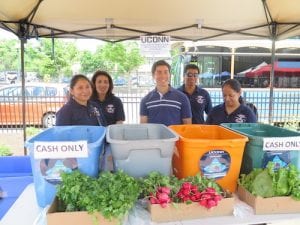 As we understand more about the novel coronavirus causing COVID-19 worldwide, we are constantly updating information and resources to help guide the fruit and vegetable farming community in Connecticut. Please use this resource document with links to information relevant to CT farmers.
As we understand more about the novel coronavirus causing COVID-19 worldwide, we are constantly updating information and resources to help guide the fruit and vegetable farming community in Connecticut. Please use this resource document with links to information relevant to CT farmers.
It can be easier to adapt to a constantly changing scenario if there are studies or examples to follow. Some farmers markets have changed the way they do business to implement some of the best food safety practices. Here is information from what some farmers’ markets and CSAs are doing. The following was adapted from information compiled by Chris Callahan, UVM.
- Carrborro, NC Farmer’s Market Case Study – NC State Extension has posted a summary of what the Carrboro Farmers’ Market has done. Briefly, this included communication with market customers, physical distancing by rearranging the market layout, rounding prices for limited use of coins, running a “tab” for customers to minimize cash transactions, no samples, no tablecloths to ease sanitation, and the addition of a hand washing station among other things.
- Minimize the Number of Touches (CSA) – One CSA has decided to change how they distribute to an urban market. They have previously trucked larger bins of produce to a distribution site where customers would select their own produce to fill their share. They have decided to pack the shares to order at the farm prior to distribution to minimize the number of people touching the produce. Another alternative would be packing shares to order at the market.
- Minimize the Number of Touches (Farmers’ Market) – The Bennington Farmers’ Market in Vermont has shifted to online ordering and pre-bagged orders from each farm that are combined into larger collective orders delivered to each customer via a drive-up system. The biggest decision was deciding that they’d actually continue to have the market. The new approach required the addition of an on-line ordering system (Google Forms for now), coordination among farms and some serious organization at the market. Orders are organized alphabetically; pickups are scheduled with a quarter of the alphabet every 30 minutes. People won’t get out of their cars.
- What are some other farms doing? Some farms have written and implemented specific response plans or taken other measures to mitigate the risk of COVID-19. For example, Two Farmers Farm in Scarborough, Maine have developed a detailed, yet flexible farm plan available online.
If you would like to share what your operation is doing to ensure food safety and have suggestions for the community to combat COVID-19, please feel free to email me at indu.upadhyaya@uconn.edu.
Meanwhile, stay healthy and safe and we will keep you updated with the latest information as we learn more.
By Indu Upadhyaya, DVM, MVSc, PhD
Assistant Extension Educator, Food Safety, UConn Extension